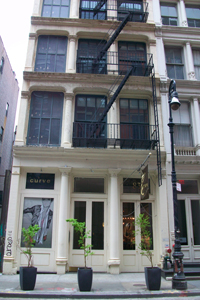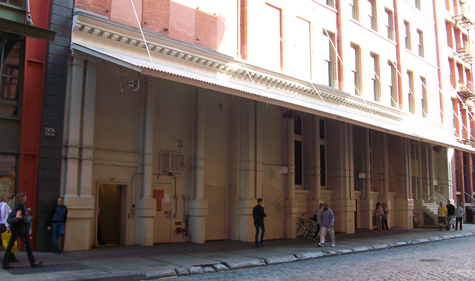Human Flower Project
Mercer Street, You Could Be Cooler
SoHo presents problems for urban ecologists, but a little goes a little way, and there’s a long way to go.
 Chic shops along Mercer St., NYC, opt for signage and display-windows over greenery
Chic shops along Mercer St., NYC, opt for signage and display-windows over greenery
Photo: Georgia Silvera Seamans
Mercer Street, SoHo (south of Houston) is one of New York City’s cool streets but not because of its shade trees. In fact, there are only three street trees on Mercer. The street’s cool factor derives from the many boutique shops – Prada, Curve (pictured, left), Kate Spade, Rag & Bone, UGG among others – along its six-block length between Houston and Canal Streets (there are six additional blocks north of Houston).
Why, might you ask, are there only three trees on this street, in a city well known for its MillionTreesNYC urban forest expansion initiative? One reason might be cultural/commercial. Trees can block historic building facades and hip signage, thus reducing shop visibility. Preference survey research conducted by Kathleen L. Wolf has found that “merchants have less appreciation for trees than the people they wish to welcome to their shops.” Wolf also observed that “consumers respond positively to shopping environments having a healthy urban forest.” However, the lack of tree canopy on Mercer has not hampered shoppers!
Wolf’s town of Seattle recommends trees as “good for business and the environment.” Seattle’s Office of Economic Development has made its position clear:
Trees provide enormous environmental and economic benefits. Recent research conducted by the University of Washington indicates that districts with street trees attract more shoppers, who are willing to pay as much as 11% more for products. The City encourages street trees and community-initiated tree plantings and offers many resources. The Seattle Department of Transportation (SDOT) offers information, expertise and other resources to help business districts plant and maintain trees. Investing in trees can bring the following returns:
• Increase in property values—especially full-grown healthy trees.
• Increase in the number of shoppers, and increase in perceived product value and customer service in a business district.
• Trees help mitigate air pollution, slow storm water runoff and save energy by shading buildings in summer and letting in light in the winter.
• Trees and greenery are psychologically and aesthetically pleasing.
Another reason for the lack of trees along Mercer is that trees in the SoHo district are considered, by some, to be “historical inaccurate.” The New York Times reported that in 1994, the Landmarks Preservation Commission “rejected the planting of trees, saying they would mar the historical integrity of the Cast Iron District.”

Overhangs along Mercer have deterred urban gardeners and arborists
Photo: Georgia Silvera Seamans
Along with reduced visibility and change in neighborhood tradition, other factors that affect the capacity of Mercer Street to support street trees are infrastructural. Mercer, for the most part, is lined with vaulted sidewalks and overhangs. Sidewalks on Mercer and in the SoHo (south of Houston neighborhood) were built over basement storage spaces, which are still used by the businesses that line the street.
A shopping district can be landscaped with other plants, not just trees, Wolf found. “Plants and trees, if properly selected and maintained, create a pleasant space.” What Mercer lacks in trees it has, to some degree, made up with using small planter gardens.

Nearby Broome Street has large trees in planters: effective but uncounted in New York City’s ongoing tree initiative
Photo: Georgia Silvera Seamans
Although the planters provide spots of green, Mercer Street could take a lesson from the block of Broome between Mercer and Broadway, where tree planter-boxes have been installed. There’s a hitch, though. Trees in planter boxes (shrubs, too) are not accounted for in NYC’s Million Trees initiative!
Planter gardens – whether shrub, tree, or herbaceous – are not unique to Mercer Street or to New York City. These gardens are often installed as part of a beautification initiative. This summer, downtown Iowa City is lined with “red wagons serving as flower planters,” reported Josh O’Leary of the Iowa City Press-Citizen.
“We just think it’s a great way to beautify downtown and draw attention to the entryways of shops,” said Nick Arnold, director of the Downtown Association. “It provides something colorful to draw people’s eyes and spruce up downtown a little bit.”
 Along Mercer Street, small evergreens in planters make a big impact
Along Mercer Street, small evergreens in planters make a big impact
Photo: Georgia Silvera Seamans
The impulse to beautify city streets with plants is historic and large-scale. In my dissertation research, I found that beautification was the main historic reason for street tree planting in San Francisco. Daniel Burnham, famous for his 1909 Plan for Chicago, emphasized “the beauty imparted to streets by tree planting” in his 1905 Plan for San Francisco. Almost half a century later, private citizen Glen Hall, in his “Outline of a Street Tree Program for San Francisco” (1945) wrote, “It is evident then that the chief value of street planting in San Francisco is for its ornamental effect.”
Burnham’s plans were directly influenced by the City Beautiful Movement of the early 20th century. Later urges to beautify cities appeared in the Keep America Beautiful campaign, launched in 1953; in Lyndon Johnson’s urban beautification program via the 1965 Housing Act; and, most famously, through Lady Bird Johnson’s Society for a More Beautiful National Capital (also in 1965).
Comments
Nice article about a great neighborhood (which, as you pointed out, can still be improved!)
Thank you, Jim and RS.
Jim, I agree that the historic landscape argument is a weak one, especially in light of the fact that prior to urbanization, this part of Manhattan was heavily forested, according to the Mannahatta Project Map. See http://themannahattaproject.org/explore/mannahatta-map/


Great article, Georgia! The “historical integrity” ploy to ban street trees is simply absurd.